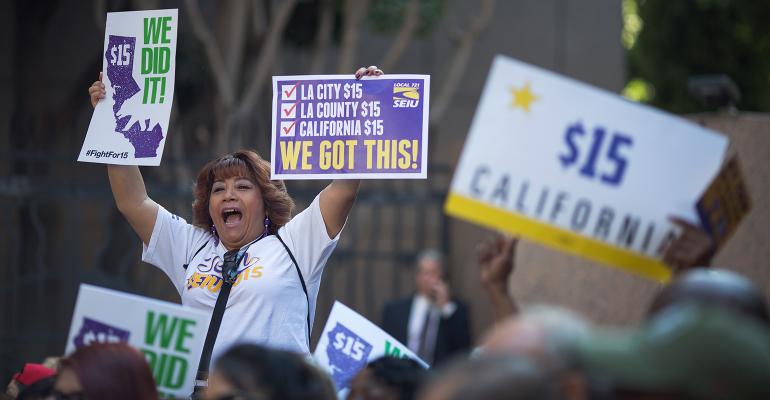Another new year brings another round of minimum wage hikes in 18 states.
The federal minimum wage remains at $7.25 per hour, with a tipped wage in some states at $2.13 per hour. But many states are taking action with wage hikes scheduled to go into effect on Dec. 31 or Jan. 1, 2018.
In 10 states, the increases are part of a phased-in transition to reach a certain level, eventually $15 per hour in states like New York and California.
Another eight states will see annual cost-of-living index adjustments, including Alaska, Florida, Minnesota, Missouri, Montana, New Jersey, Ohio and South Dakota.
Additionally, in Washington, D.C., and Oregon, wage hikes are scheduled to go into effect in July, rather than Jan. 1, 2018. In the District of Columbia, the minimum wage of $12.50 per hour will increase to $13.25 per hour, and in Oregon the standard rate of $10.25 increases to $10.75 on July 1, although wage rates are higher for employers in the Portland area.
Another 20 cities and counties across the country will also raise minimum wages on the first of the year, and more wage hikes are coming. Campaigns are underway to raise the minimum wage floor in at least 17 more states and cities, including Massachusetts, New Jersey, Vermont, Illinois, Missouri, Michigan and Nevada, according to the National Employment Law Project.
Here’s a look at where the minimum wage will go up in 2018. Except where noted, all of these increases take effect on Jan. 1, 2018:
Arizona: The current hourly minimum wage of $10 increases to $10.50 per hour. The rate is scheduled to go up by another 50 cents in 2019, reaching $12 per hour by 2020. In 2021, cost-of-living indexing will begin.
California: The current rate of $10.50 per hour increases to $11 per hour, and is on track to reach $15 by 2022. Small businesses with 25 or fewer employees will have an extra year to comply, reaching $15 in 2023. Once the rate hits $15, cost-of-living increases kick in.
Colorado: The current rate of $9.30 per hour increases to $10.20 per hour, with future increases to $11.10 in 2019, then to $12 in 2020, with indexing starting in 2021.
Hawaii: The rate of $9.25 per hour increases to $10.10 per hour.
Maine: The $9 per hour wage increases to $10 per hour, with future increases to $11 in 2019, $12 in 2020 and indexing in 2021.
Michigan: The $8.90 per hour wage increases to $9.25, and indexing begins in 2019.
New York: The minimum wage of $9.70 per hour for most of the state increases to $10.40 per hour on Dec. 31, with continued increases scheduled until reaching $12.50 in 2020. At that point, increases will be based on cost of living to get the wage to $15 per hour.
In New York City, the minimum wage for employers of 11 or more people increases to $13 per hour on Dec. 31, and $12 per hour for smaller businesses. The rate increases for smaller businesses annually to reach $15 in 2019. On Long Island and in Westchester, the rate increases to $11 on Dec. 31.
Rhode Island: The current rate of $9.60 per hour increases to $10.10, with future increase to $10.50 per hour in 2019.
Vermont: The $10 per hour minimum wage increases to $10.50 per hour, with additional indexing beginning in 2019.
Washington state: The current $11 per hour wage increases to $11.50, with future increases to $12 in 2019, and $13.50 in 2020, with indexing beginning in 2021.
Sources: U.S. Department of Labor/National Conference of State Legislatures, Business for a Fair Minimum Wage
Contact Lisa Jennings at [email protected]
Follow her on Twitter: @livetodineout

